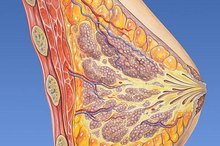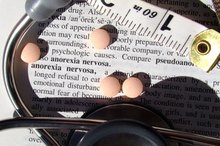What Makes Breasts Grow Bigger?
Puberty and Menstruation
The most obvious cause of breast enlargement is puberty. During this period of a girl's life, the ovaries start to produce estrogen. This hormone causes fat to accumulate in the breasts. The accumulating fat causes the breasts to grow outwards until they reach their adult size. After a girl starts having her periods, she may experience temporary breast swelling during the times of the month right before she begins to menstruate. This short-term growth is caused by glands in the breasts growing bigger in case of pregnancy. Once menstruation begins, the breasts return to their normal size 1.
- The most obvious cause of breast enlargement is puberty.
- This hormone causes fat to accumulate in the breasts.
Contraception and Pregnancy
What Hormone Makes Your Breasts Grow?
Learn More
During pregnancy, the hormone progesterone readies the breasts to produce milk. The breasts grow larger due to additional fat and swollen milk glands. The breasts stay enlarged while the mother breastfeeds her infant. Once the baby is weaned off breast milk, the breasts often return to their original size or may even become smaller. Using a hormonal method of contraception, such as the birth control pill, can also make breasts larger as such methods contain hormones that mimic the effects of pregnancy. The side effect of fluid retention can also swell the breasts.
- During pregnancy, the hormone progesterone readies the breasts to produce milk.
- Using a hormonal method of contraception, such as the birth control pill, can also make breasts larger as such methods contain hormones that mimic the effects of pregnancy.
Weight Gain and Exercise
Since the breasts contain fat, if a woman gains weight in the form of fatty tissue, her breasts might grow bigger as well. Exercise can decrease breast size by burning off fatty tissue. Exercising the pectoral muscles underneath the breasts can counteract the lost fatty breast tissue. Larger pectoral muscles give the illusion of larger breasts. Strong pectorals can also make the breasts appear firmer. Push-ups, chest presses, chest flies and incline presses are some of the many exercises that can help strengthen the pectorals.
- Since the breasts contain fat, if a woman gains weight in the form of fatty tissue, her breasts might grow bigger as well.
- Strong pectorals can also make the breasts appear firmer.
Related Articles
References
- What to Expect When You're Expecting--Breast Size After Pregnancy
- Ohio State University Medical Center--Normal Breast Development
- Winocour S, Lemaine V. Hypoplastic Breast Anomalies in the Female Adolescent Breast. Semin Plast Surg. 2013;27(1):42–48. doi:10.1055/s-0033-1343996
- Cruz NI. Breast Asymmetry in Women Requesting Plastic Surgery of the Breast. P R Health Sci J. 2018;37(4):230‐238.
- Chen JH, Chan S, Yeh DC, Fwu PT, Lin M, Su MY. Response of bilateral breasts to the endogenous hormonal fluctuation in a menstrual cycle evaluated using 3D MRI. Magn Reson Imaging. 2013;31(4):538-44. doi:10.1016/j.mri.2012.10.022
- Kader T, Hill P, Rakha EA, Campbell IG, Gorringe KL. Atypical ductal hyperplasia: update on diagnosis, management, and molecular landscape. Breast Cancer Res. 2018;20(1):39. doi:10.1186/s13058-018-0967-1
- Hisham A. Juvenile Breast Hypertrophy: A Successful Breast Reduction of 14.9% Body Weight without Recurrence in a 5-Year Follow-Up. Case Rep Surg. Volume 2017, Article ID 3491012. doi:10.1155/2017/3491012
- Kayar R, Çilengiroğlu ÖV. Breast Volume Asymmetry Value, Ratio, and Cancer Risk. Breast Cancer (Auckl). 2015;9:87-92. doi:10.4137/BCBCR.S32789
- Reilley Ann F. Breast Asymmetry: Classification and Management. Aesthetic Surg J. 2006;26(5):596-600. doi:10.1016/j.asj.2006.07.006
- Cruz NI. Breast Asymmetry in Women Requesting Plastic Surgery of the Breast. PR Health Sci J. 2018 Dec;37(4):230-238.
Writer Bio
J.D. Wollf has been a writer since 1999 and has been published in a variety of newspapers and newsletters. She has covered everything from local sports to computer accessory reviews and specializes in articles about health issues, particularly in the elderly.








